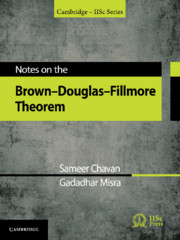Book contents
- Frontmatter
- Dedication
- Contents
- Preface
- From: The Evolution of Modern Analysis, R. G. Douglas
- Overview
- 1 Spectral Theory for Hilbert Space Operators
- 2 Ext(X) as a Semigroup with Identity
- 3 Splitting and the Mayer–Vietoris Sequence
- 4 Determination of Ext(X) as a Group for Planar Sets
- 5 Applications to Operator Theory
- Epilogue
- Appendix A Point Set Topology
- Appendix B Linear Analysis
- Appendix C The Spectral Theorem
- References
- Subject Index
- Index of Symbols
Epilogue
Published online by Cambridge University Press: 30 June 2021
- Frontmatter
- Dedication
- Contents
- Preface
- From: The Evolution of Modern Analysis, R. G. Douglas
- Overview
- 1 Spectral Theory for Hilbert Space Operators
- 2 Ext(X) as a Semigroup with Identity
- 3 Splitting and the Mayer–Vietoris Sequence
- 4 Determination of Ext(X) as a Group for Planar Sets
- 5 Applications to Operator Theory
- Epilogue
- Appendix A Point Set Topology
- Appendix B Linear Analysis
- Appendix C The Spectral Theorem
- References
- Subject Index
- Index of Symbols
Summary
So far, we have exclusively focussed on the original proof [26, Theorem 11.1] of Brown, Douglas, and Fillmore classifying essentially normal operators. In what follows, we will refer to this proof as the “BDF proof”. We have therefore left out other proofs that simplify parts of the BDF proof. Indeed, there is a proof of the BDF theorem proposed by O’Donovan [104] that separates the techniques obtained from homological algebra and algebraic topology used in the proof of BDF from that of techniques obtained from operator theory. Although, it might appear surprising at first, it turns out that the BDF theorem is actually equivalent to what may appear to be a much simpler statement: If the index of an essentially normal operator T is trivial, then T must be of the form N + K for some normal operator N and a compact operator K. This is Exercise 4.6.4.
As we have seen, it is not difficult to show that Ext(X) is an abelian semi-group. With a little more effort, the existence of a unique element that serves as the identity in Ext(X) is established. However, the proof in [23] of the existence of the inverse in Ext(X) is intimidating. A simpler proof due to Arveson [6] (see also [40]) appeared soon afterwards. Secondly, the BDF theorem established that Ext is a covariant functor from the category of compact metric spaces to abelian groups (Corollary 2.7.1) naturally leading to the question of its connection with other known functors from topology. This question was investigated vigorously and its connections with K-theory was eventually established on a firm footing. We discuss some of these developments in the following sections.
Finally, we conclude this short chapter with the discussion of several open problems, which include the Arveson–Douglas conjecture for semi-invariant modules of Hilbert modules over function algebras and the problem of classifying commuting “homogeneous” essentially normal operators.
Other Proofs
Here we briefly summarize the simplification due to Arveson of the proof that Ext(X) is a group. There were two other papers, one by Davie and the other by O’Donovan, that provided simplifications to parts of the BDF proof. We describe them in this section.
- Type
- Chapter
- Information
- Notes on the Brown-Douglas-Fillmore Theorem , pp. 179 - 192Publisher: Cambridge University PressPrint publication year: 2021

